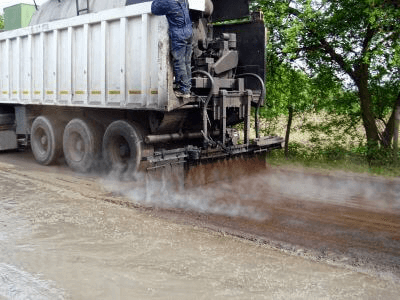What Are Asphalt Emulsions?
 Asphalt Emulsions are materials that can be applied at room temperature. It can be applied at room temperature, whereas asphalt is usually applied in liquid form after heating.
Asphalt Emulsions are materials that can be applied at room temperature. It can be applied at room temperature, whereas asphalt is usually applied in liquid form after heating.
Uses of Asphalt Emulsion
1. Road Paving
Asphalt emulsion is used as a prime coat or tack coat for asphalt pavement. Asphalt pavement generally consists of a roadbed formed by crushed stones on the ground, a base layer and a surface layer formed by placing a heated asphalt mixture on top of the roadbed.
Asphalt emulsion is spread on the surface of the roadbed after the roadbed is formed to form a prime coat that improves the fit between the roadbed and the base layer that is formed on top of it. It is sometimes referred to simply as an emulsion. When used as a prime coat, it also has the effect of penetrating into the roadbed surface and stabilizing it.
It is also effective in preventing scouring of the roadbed due to rainfall, preventing surface water penetration, and blocking the capillary rise of moisture from the roadbed. Asphalt emulsion may also be sprayed on the surface of the base layer after the base layer is formed to form a tack coat that improves the fit between the surface layer and the base layer that is formed on top of it.
In other cases, they are spread after the formation of the surface layer to treat the surface of the pavement. Asphalt emulsions are also suitable for waterproofing structures other than pavements.
2. Promotion of Greening
Asphalt emulsions are also used to promote greening. For example, when seeds are sown on the surface, they will be washed away by rain.
However, if a mixture of seeds, soil, fertilizer, and water is sprayed on the surface and then covered with the emulsion, the seeds can be protected from erosion by rain. Asphalt emulsion is therefore also suitable for promoting revegetation.
Principle of Asphalt Emulsion
Asphalt emulsion is made by dispersing fine particles of asphalt in water using an emulsifier. They can be sprayed at room temperature. After spraying, the water and asphalt particles separate, causing the asphalt particles to aggregate and form an adhesive film.
The main components are straight asphalt, water, and emulsifiers, with the main component, straight asphalt, accounting for 50% to 70% of the total. After straight asphalt, water is the next most abundant component, followed by emulsifiers.
Types of Asphalt Emulsions
Asphalt emulsions are classified into three categories based on the type of emulsifier, which is a surfactant: cationic emulsion, anionic emulsion, and nonionic emulsion.
Although emulsifiers are less abundant than other components, their properties greatly affect the properties of asphalt emulsions.
1. Cationic Emulsions
Cationic emulsions are emulsifiers for cationic emulsions. After spraying, the water and asphalt particles easily separate and a film is formed without waiting for the water to evaporate.
Cationic emulsions account for most of the asphalt emulsions used in asphalt paving because they can quickly form a film on the surface of crushed stone.
2. Anionic Emulsion
Anionic emulsions are emulsions that use an anionic emulsifier. They have the disadvantage that it is difficult for water and asphalt particles to separate and it takes time to form a film.
However, they are highly stable as emulsions and can be stored for long periods of time. They are used as slurry seals, asphalt emulsions for waterproofing, etc.
3. Nonionic Emulsions
Nonionic emulsions are emulsifiers. They are characterized by their lack of electrical charge and high chemical stability. They can be easily mixed with alkaline materials such as cement, and are used as emulsions for roadbed reclamation methods and cement emulsion mortars.
Other Information on Asphalt Emulsion
Advantages of Asphalt Emulsion
Ordinary asphalt has low fluidity at room temperature. Therefore, when it is used for road paving, it must be heated to several hundred degrees celsius or mixed with organic solvents. This causes problems such as the generation of foul odors when heated.
Asphalt emulsion, on the other hand, does not require heating and can be applied at room temperature. Therefore, the use of asphalt emulsions is expanding as they are easy to handle, do not generate foul odors, and contribute to the environment by reducing carbon dioxide emissions.